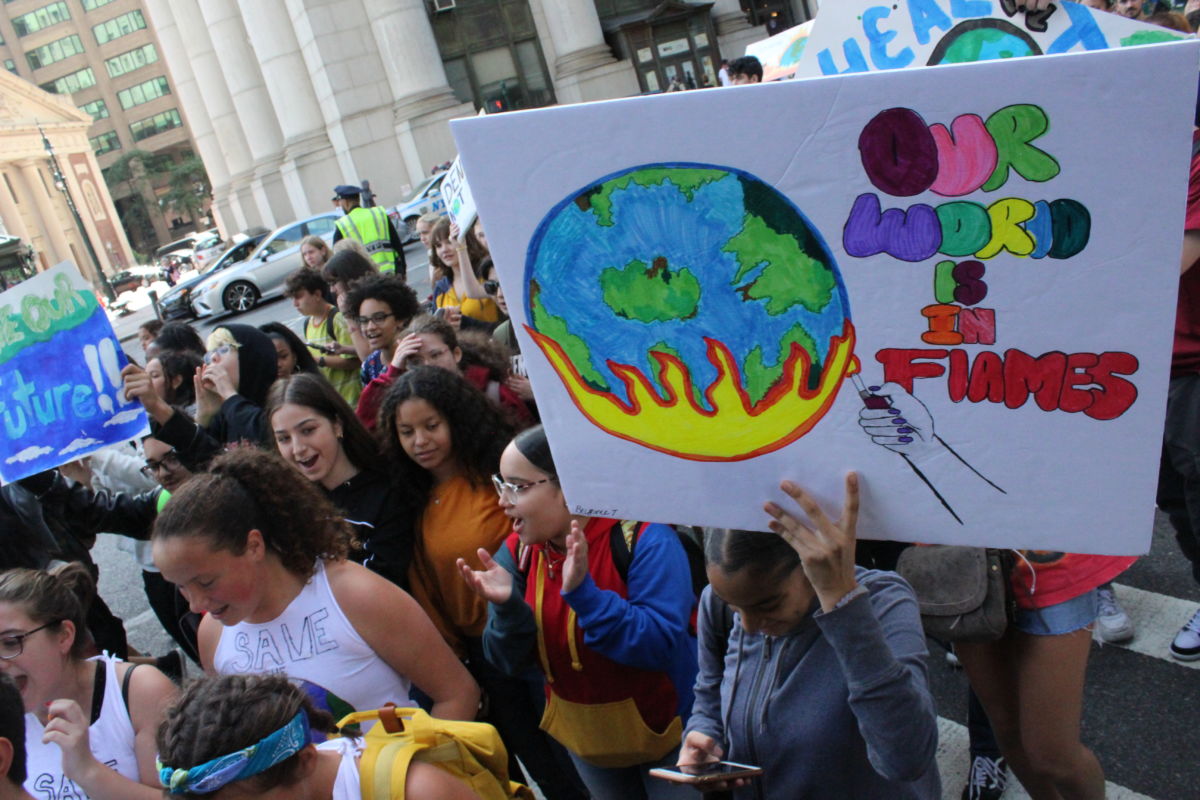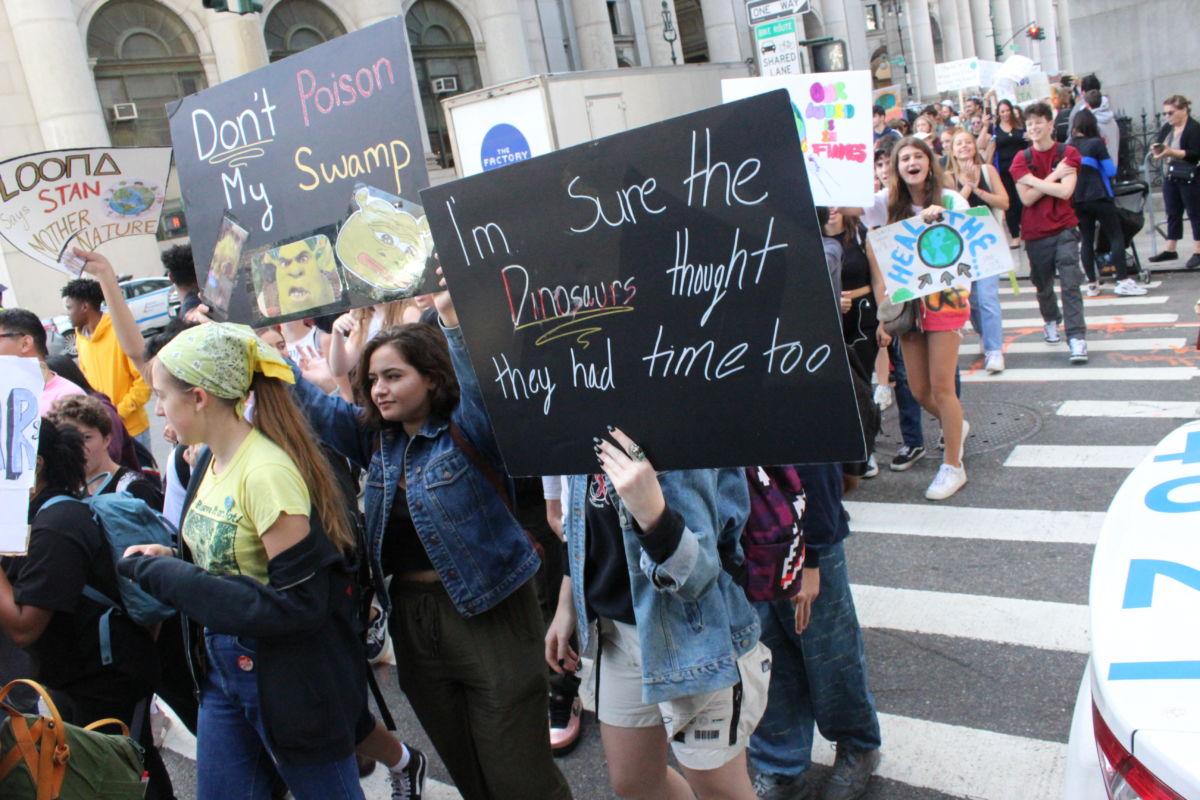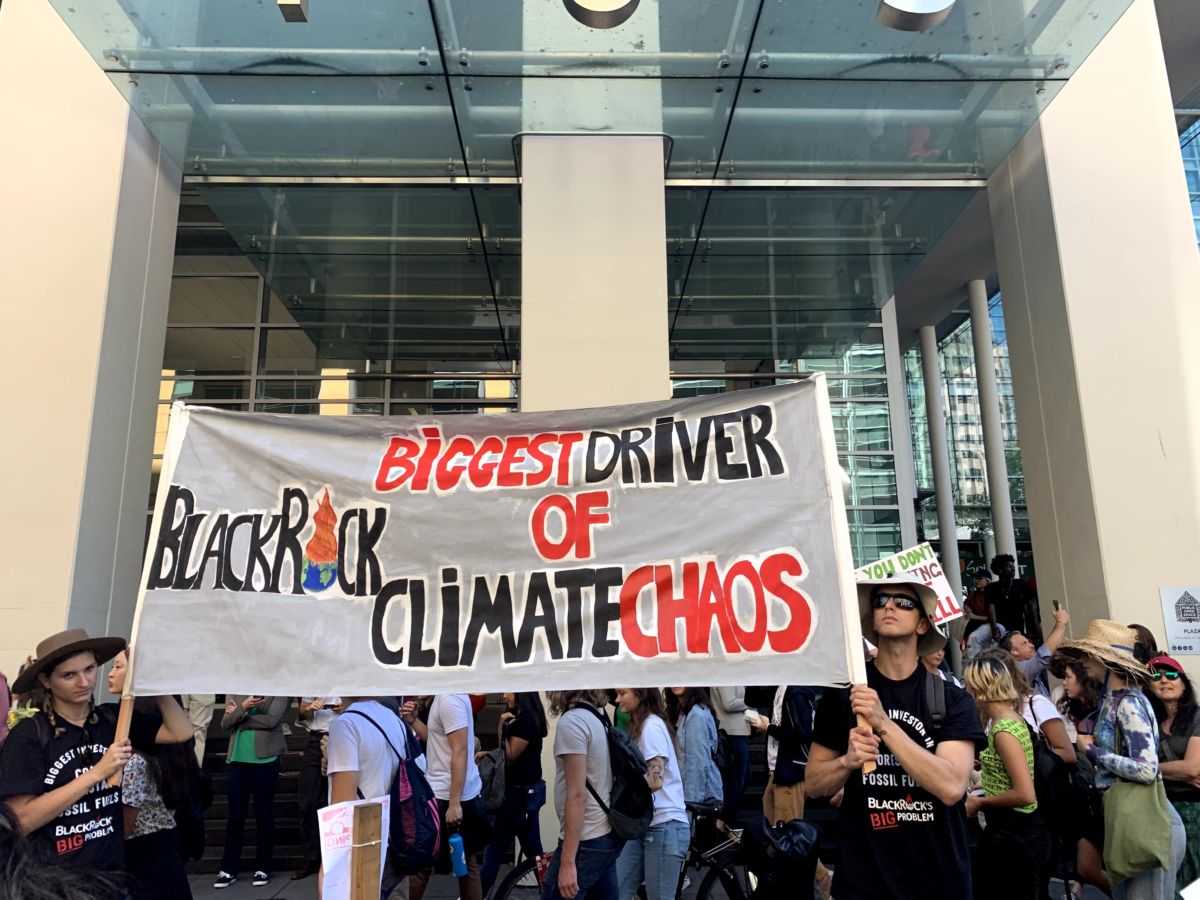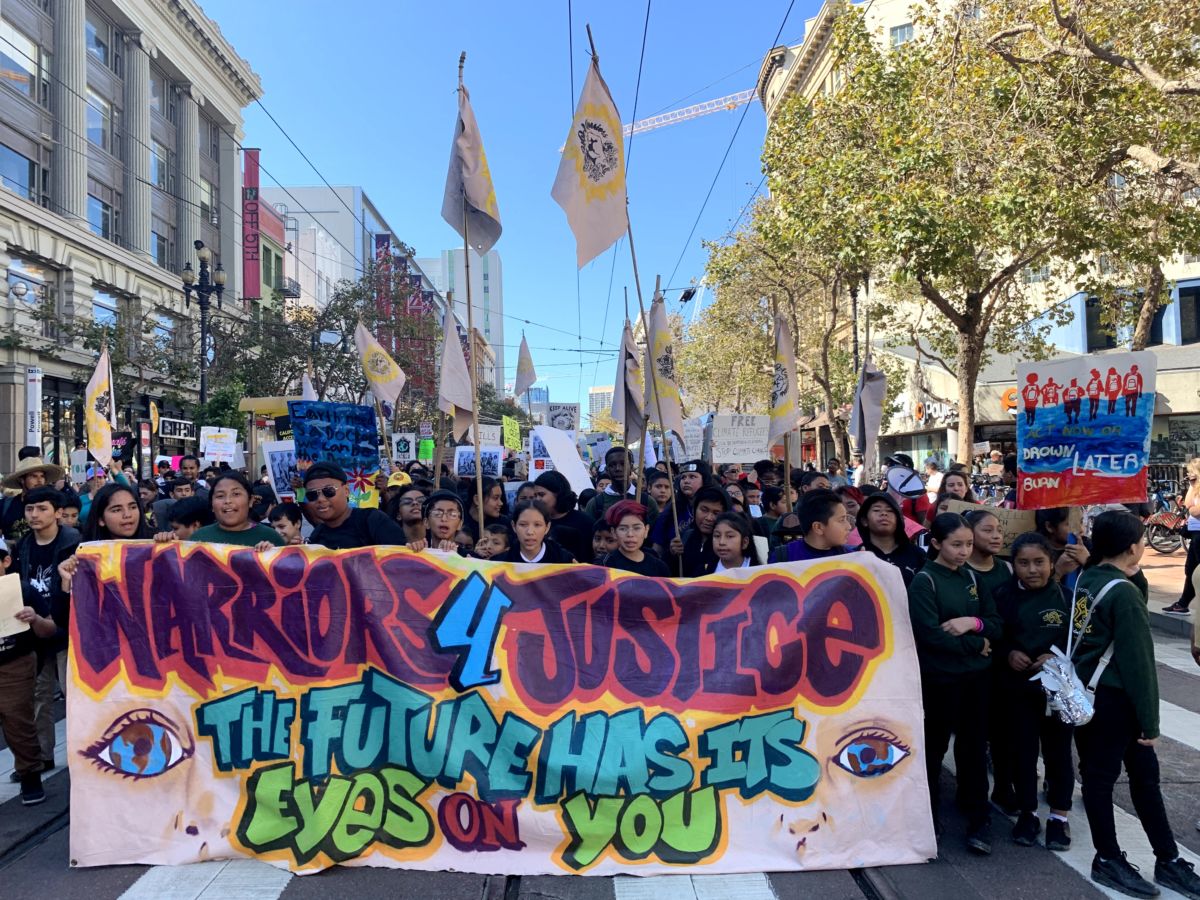Part of the Series
Covering Climate Now
At 8:45 a.m. on Friday, September 20, sixth grade humanities teacher Corinne Jong boarded a school bus packed with Urban Promise Academy middle schoolers, snare and bass drums, and a banner bursting with hand-painted orange, green and black letters that read, “The Future Has Its Eyes on You.” After crossing the Bay Bridge that connects Oakland to San Francisco, the bus dropped Jong and her students as close to House Speaker Nancy Pelosi’s office as the driver could get, joining over 4 million people worldwide participating in the Global Climate Strike. The group proceeded to Bank of America, Senator Dianne Feinstein’s office and the Amazon Go store — which locked its doors as strikers passed. After a few more stops, they landed in Sydney G. Walton Square, where a few of Jong’s students stood on stage and addressed tens of thousands in the crowd.
Jong is one of hundreds of educators across the United States who have responded to youth climate activists’ formal request in May that adults leave the sidelines and fully engage in the September 20 climate strike. In early September, nine prominent climate scientists published a petition calling on educators to “act with urgency and solidarity by leaving our classrooms together.” It received over 700 signatures, the majority from university professors.
A handful of primary and secondary teachers signed the same petition, including educators in New Mexico, Tennessee, Kentucky and Virginia, many of whom are frustrated by how little climate topics factor into traditional public school curricula. Eight U.S. labor unions officially supported the climate strike, including the Massachusetts Teachers Association, which offered suggestions for teachers looking to support students, including signing “no major assignment” pledges to allow students to attend without academic penalties. The American Federation of Teachers (AFT) offered a more vague statement of support.

Like many of these educators, Jong planned her field trip months ago and filed paperwork with the Oakland Unified School District over the summer. Jong told Truthout her administrators were supportive, and it helped that this wasn’t the first time the school’s students had gone on a climate action-related field trip. Teachers across the bay in the San Francisco United School District were dealt a tougher hand. After weeks of planning, applying and getting approved to go on field trips to the climate strike, Superintendent Vincent Matthews’ office announced over email the Monday before the strike that teachers were not to take students to the event. One San Francisco public school teacher, who asked to remain anonymous for fear of losing her job, had planned to bring her third-grade students to the action as the culmination of a climate science unit. The superintendent’s office seemed to be concerned the trip would constitute “forced political speech.” But the teacher says her trip was simply designed to connect the science students had learned in class to the excitement at such a big event — to show kids “why becoming an expert in science is so important and so interesting.” District officials did not budge on this decision even after teachers put out a petition asking the superintendent to reconsider.
Skipping school was less complicated for students in New York City and Boston, where school district officials approved absences for students whose parents wrote them an excuse note. About two-thirds of students at the Beacon School in New York City poured out of class doors midday in time to join the thousands on strike in New York, estimates Bayard Faithfull, who is a history teacher at the school. Faithfull says the excuse-note announcement made the strike much more accessible for public school students and generated significant last-minute publicity, which he thinks contributed to the size of the strike. In spite of the big turnout — organizers estimate 250,000 people joined the New York City strike — there’s much to be done to channel the mobilization into meaningful change. One thing Faithful says he thinks educators can work on, is satisfying what he describes as students’ urgent hunger to learn about the climate crisis.

“Most kids get about two hours of climate education in a given year,” Faithful told Truthout. “As teachers, we tend to teach what we taught last year and the year before that. The tests don’t change, the APs are still there on the same topics,” he says. “But we need to find a way to talk about this. Not just in science but in social studies classes, in math classes, and to find out how we can meet the student thirst for information as quickly as we can.”
Thirty miles away, at Farmingdale High School on Long Island, climate strike day was by and large just a regular day of school. High school science teacher Cordelia Anthony says she played a video from the AFT’s lesson share website about why students were going on climate strike, but that was about it. Unlike schools in New York City, young people at Farmingdale were not granted excused absences to go to the strike.
New York state science learning standards have begun to include more climate-related topics in recent years. (“Climate change” appears 16 times in the latest K-12 science standards.) And Anthony now technically teaches “living environment” instead of just “biology.” But she shares sentiment with educators throughout the country that the climate crisis should be incorporated into learning standards in all subject areas. “It should also start at primary grade levels,” she says. “Students should be able to know how they can do something to change the trajectory of the climate crisis and what actions they can take when they are very young so that they can see how what they do will have an impact.”
One major concern among the signatories of the Educators’ Climate Strike petition who work in higher education, according to New York University (NYU) history professor Lauren Minsky, is the fundamental hypocrisy of academia’s approach to climate education. Universities claim to be hubs of change “committed to researching and innovating solutions to the climate crisis,” Minsky told Truthout. “On the other hand … they also elect to put some of the CEOs most responsible for contributing to the climate emergency on their boards.”
The CEO of BlackRock, Larry Fink, remains on NYU’s board of trustees, for example, she said. BlackRock is the largest asset management company in the world. In addition to its tendency to block climate resolutions at companies like ExxonMobil, earlier in 2019, the company teamed up on a multibillion-dollar investment in the Abu Dhabi National Oil Company, where NYU has a satellite campus. Minsky says NYU Abu Dhabi is already “constrained in its educational practices by laws that do not allow any criticism” of the United Arab Emirates government.
University professors are also wrestling with how to change “business as usual” in pedagogy and research. As a professor of chemistry at North Seattle College, Dr. Heather Price and her colleagues in chemistry, biology and physics were trained to be “good scientists” — in other words, to gather data, present it objectively, and therefore, she says, “not [to] voice our opinions about solutions.” The result has been a kind of intensive, isolated academic practice, which she’s now trying to unlearn.
NYU politics professor Bertell Ollman calls this phenomenon “blinkers.”

“It’s like horses that go down streets in big cities wearing a hat on their head so it can’t see to the right or left,” he told Truthout. At 82 years old, he is teaching his first-ever class on climate change, which he skipped in order to strike with his students on September 20.
“100 years ago, you had a breakdown of the sciences into different schools that focus on only a set of problems that are supposed to be unique to that school or department,” Ollman said. As a result, students are taught to see things in bits and pieces. “In a sense, more [formally] educated people are even more difficult to educate on the climate crisis.”
Back in San Francisco, Jong and her middle schoolers marched toward the front of the thousands that filled the streets. A percussion group called Boom Shake accompanied the students, and chaperones flew banners high above the crowd. It would have been difficult to lose sight of the Urban Promise group — just as Jong had intended. Much like students across the country, Jong’s students report climate anxiety, which she says starts, on average, in fourth grade. September 20 was an antidote to that. Students made stencils and silk-screened their own shirts. They helped to plan the chants and draft demands.
The students were able to channel their climate anxiety toward an energized purpose, and Jong said that’s why she and other teachers at Urban Promise mix climate education with activist opportunities: “You can really see a sense of freedom and just kind of that joy of feeling that they’re finally able to say how they feel about what’s going on.”
This story is part of Covering Climate Now, a global collaboration of more than 220 news outlets to strengthen coverage of the climate story.
Press freedom is under attack
As Trump cracks down on political speech, independent media is increasingly necessary.
Truthout produces reporting you won’t see in the mainstream: journalism from the frontlines of global conflict, interviews with grassroots movement leaders, high-quality legal analysis and more.
Our work is possible thanks to reader support. Help Truthout catalyze change and social justice — make a tax-deductible monthly or one-time donation today.
